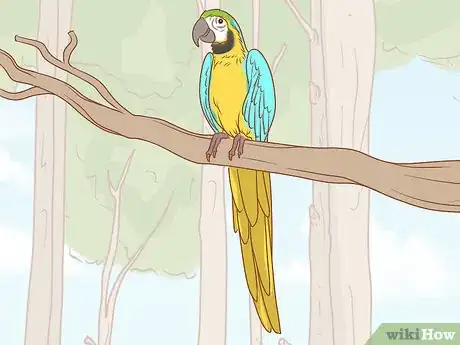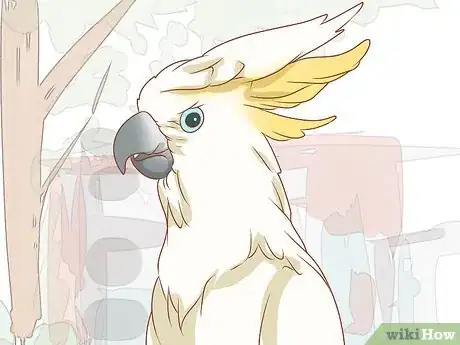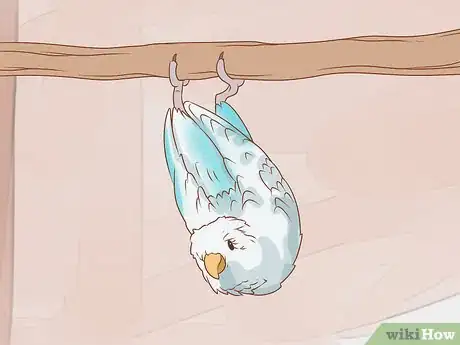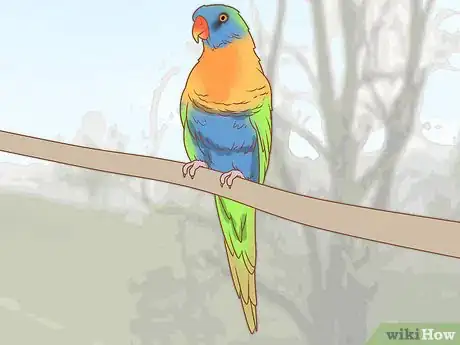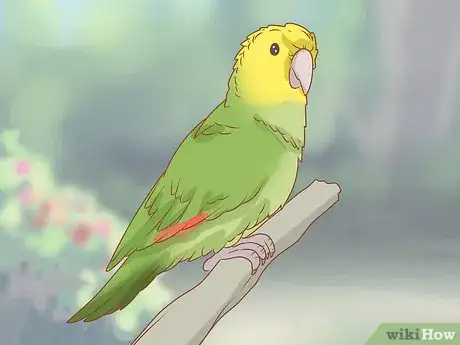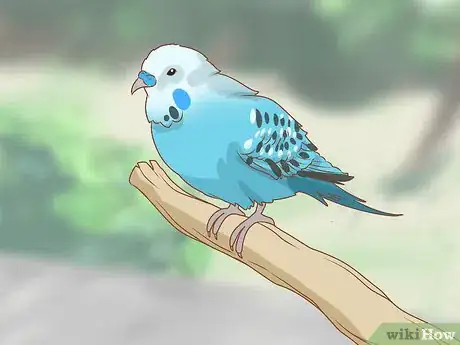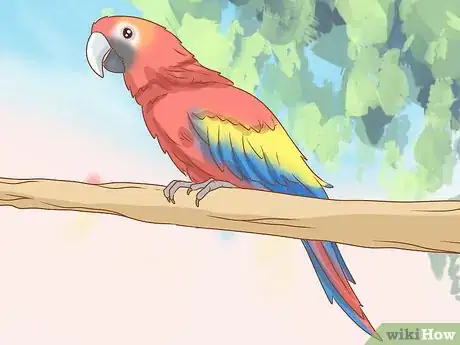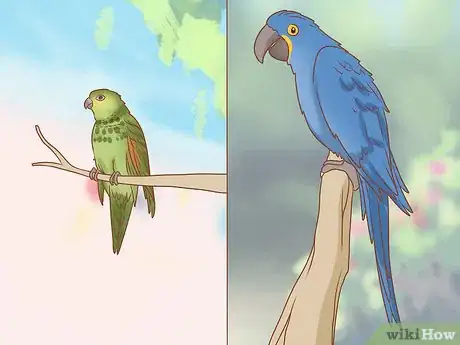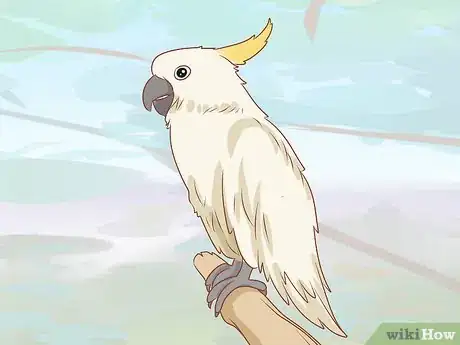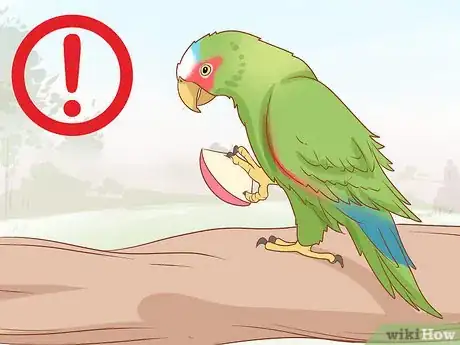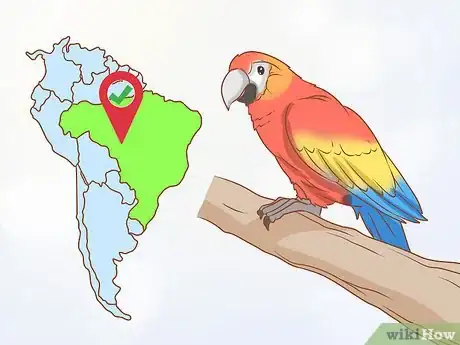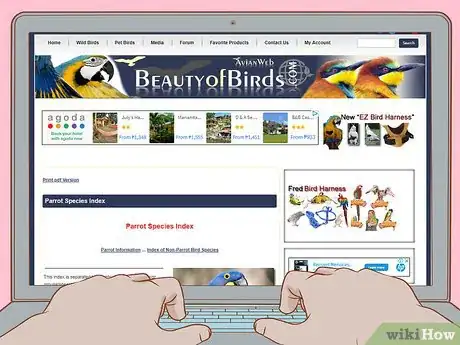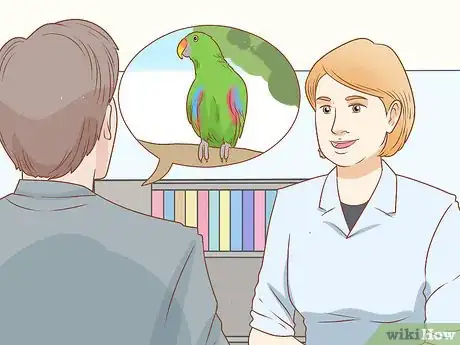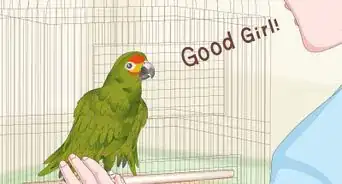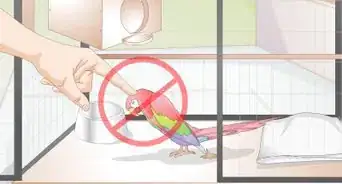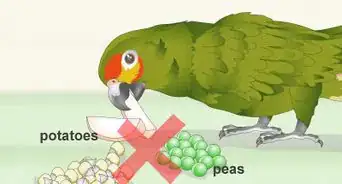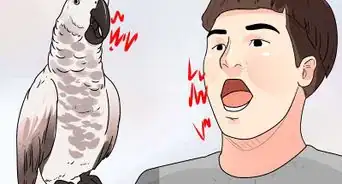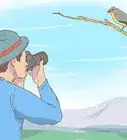This article was co-authored by Roger J. Lederer, PhD and by wikiHow staff writer, Megaera Lorenz, PhD. Dr. Roger Lederer is an Ornithologist and the founder of Ornithology.com, an informative website about wild birds. Dr. Lederer has spent over 40 years teaching, studying, and writing about birds. He has traveled to over 100 countries to study birds. Dr. Lederer is an Emeritus Professor of Biological Sciences at California State University, Chico, and has been a Department Chair of Biological Sciences and Dean of the College of Natural Sciences. He has written more than 30 research papers and 10 books on birds and a textbook entitled “Ecology and Field Biology.” Dr. Lederer has consulted the BBC, National Geographic, National Public Radio, ABC News, the Guinness Book of World Records, and numerous other organizations and publications.
There are 22 references cited in this article, which can be found at the bottom of the page.
This article has been viewed 43,628 times.
With about 400 known species of parrots in the world, identifying one of these beautiful birds can be tricky! Get familiar with some of the common parrot types so that you know what to look for. To help narrow down your mystery bird’s identity, make a few observations about its appearance, such as color and size, and behavior. If you’ve spotted a parrot in the wild and aren’t sure what kind it is, try looking at an identification guide for parrots in your region. You might also get some leads by doing an online search or talking to a bird specialist.
Steps
Recognizing Common Types of Parrots
-
1Identify macaws by their bright colors and extra-large size. There are many different types of macaws, but most of them are characterized by colorful plumage and a large body size. The hyacinth macaw can grow up to 40 inches (100 cm) in length! These parrots are native to the Americas. If you see a huge parrot with a loud voice and feathers that are bright blue, red, yellow, green, or a combination of several of those, you may have seen a macaw.[1]
- The blue-and-yellow macaw is one of the most popular and iconic pet parrots. These parrots can grow up to 36 inches (91 cm) long, and are characterized by their powerful black beaks, yellow chest plumage, and vibrant blue backs and wings. They typically have white areas on their faces marked by rows of small, black feathers around the eyes.
- Other types of macaw include the scarlet macaw, great green macaw, and military macaw.
-
2Check for a crest to spot a cockatoo. Cockatoos are distinguished from other types of parrots by the crests of feathers on their heads, which they can raise or lower to show their emotions. These birds are native to Australia, Indonesia, and the Philippines, and are also popular in the pet trade worldwide. Look for parrots with plumage that is white, black, pink, yellow, or red, and check for a crest or fan of feathers on top of the head.[2]
- While most species of parrots are primarily green, this color is not found among cockatoos or their smaller cousins, the cockatiels.
- Most cockatoos are medium to large-sized parrots.
- A few of the most popular types of pet cockatoos are the sulfur-crested cockatoo, the umbrella cockatoo, and the salmon-crested cockatoo.[3]
Advertisement -
3Look for small size and a big personality to recognize conures. If you see a small parrot with a pointed tail and bright plumage, it may be a conure.[4] You can also recognize these birds by their playful behavior—they may hang upside down or bounce and bob with excitement. Conures are native to South and Central America.
- Conures come in a variety of colors, including green, blue, yellow, grey, and black. Most species will display a combination of these colors—for example, the green-cheek conure is primarily green with black and grey plumage on its head, a red tail, and some blue feathers on its wings.[5]
-
4Recognize lorikeets by their ultra-bright colors. Lories and lorikeets are small to medium-sized parrots with some of the most colorful plumage in the parrot family. Look for brightly-colored beaks and multi-hued plumage in vivid shades of red, green, blue, or yellow. You may also notice these birds eating flowers and lapping up the nectar with their unique, brush-tipped tongues.[6]
- These parrots are native to southeast Asia, Polynesia, and Australia.
- The rainbow lory is one of the most popular and identifiable lorikeets. These birds have red-orange beaks, blue and black faces, and red chests. They have green plumage on their backs and wings, and yellow feathers on the backs of their heads and on their legs.[7]
-
5Use green coloring and a large size to identify Amazon parrots. These South American birds make popular pets. They are relatively large, reaching up to 16 inches (41 cm) in length, and you can also recognize them by their predominantly green coloring and their blunt tail feathers. Look for splashes of other colors, such as a bit of red or yellow around the head or wings.[8]
- Some popular types of Amazon parrots in the pet trade include the double yellow-headed Amazon, the lilac-crowned Amazon, and the yellow-naped Amazon.
-
6Spot African greys by looking for silver plumage and a red tail. African grey parrots are easy to recognize thanks to their distinctive coloring. Look for a relatively large parrot (up to 13 inches (33 cm) long) with silver-grey plumage that may be darker on the wings and back. Many of these parrots have red tails. You might also notice a white mask around the eyes and a powerful black beak.[9]
- These parrots are native to West and Central Africa, but they are very popular in the worldwide pet trade thanks to their beauty, intelligence, and exceptional speaking ability.
-
7Watch for small size and black wing markings to identify budgies. Budgerigars are tiny parrots native to Australia. You may know them better as budgies or parakeets. Look for an ultra-small size (budgies are usually no more than about 8 inches (20 cm) in length) and plumage that is predominantly yellow, green, or blue. You will probably also notice black stripes and bars on the back and wings, as well as a flat beak that can hide among the feathers of the bird’s face.[10]
- Budgies are one of the most popular pet birds worldwide. Like many of their larger cousins, they are excellent mimics and can be taught to speak.
Observing the Parrot’s Features
-
1Make note of the parrot’s color. Most species of parrots are colorful, and their bright colors can be a great starting point for identifying individual species. Observe the colors of the parrot’s feathers, eyes, and beak, and note whether the parrot is predominantly one color or multiple colors. Pay attention to how the colors are distributed on the parrot’s body, as well.
-
2Observe the parrot’s size. Parrots come in a wide variety of sizes, from tiny pygmy parrots to gigantic macaws. Birds in the parrot family can range in length from 3.5 inches (8.9 cm) to 40 inches (100 cm).[13] Try to get a sense of where a parrot falls on this spectrum so you can narrow down its identity.
- Smaller species include lovebirds, budgerigars (commonly known as budgies or parakeets in the pet trade), parrotlets, and some types of parakeets (such as Bourke’s parakeet).
- Cockatiels, monk parakeets, caiques, pionus parrots, lorikeets, and poicephalus parakeets are among the medium-sized species.
- Amazon parrots, African greys, hawk-headed parrots, and some cockatoos are considered large parrots.
- Palm cockatoos and most macaws are the giants of the parrot world.
-
3Look for crests and other distinguishing features. In addition to size and color, some parrots also have crests, frills, or other distinctive features (such as a particular beak or tail shape). Observe the parrot carefully and make note of any characteristics of this sort.
- For example, cockatoos and cockatiels are known for the distinctive crests on their heads, which they can raise or lower at will.[14]
- Hawk-headed parrots have a unique, brightly-colored frill or fan of feathers around their heads that they can expand when they feel excited or distressed.[15]
- Budgies have distinctive flat beaks, often topped with a colorful cere (the fleshy part over the beak where the nostrils are located).[16]
-
4Assess the parrot’s behavior. While many parrots may have certain behaviors in common, there are differences between the species. If you have a chance to observe aspects of the parrot’s behavior such as where it lives, how it nests, and what it eats, this may help you narrow down your identification.
- For example, while most parrots prefer to spend their time in the trees, some species are ground dwellers. These include the rare night parrot, the Antipodes Island parakeet, and the kakapo.[17]
- Some parrots have unique displays or vocalizations. For example, pionus parrots make a wheezing or snorting noise when they are excited or scared.[18]
Using Identification Resources
-
1Identify the region where you saw the parrot. Parrots live in numerous tropical and subtropical regions around the globe. Some invasive species, like monk parakeets, have even made homes in temperate zones![19] If you have spotted a parrot, you can narrow down its identity by getting familiar with the parrot species that live in your area. You may find parrots in:[20]
- North, Central, and South America and the Caribbean Islands
- Africa and its surrounding islands
- Australia
- Melanesia (the islands north and northeast of Australia)
- New Zealand
- Asia
- You can then narrow the region down further. For example, if you’ve spotted a parrot in San Diego, you may wish to search for parrots of California instead of just North American parrots.
-
2Look at a guidebook about parrots that live in your region. Visit your library or check your favorite bookstore for a regional bird or parrot guide. These books are usually heavily illustrated and include descriptions of each parrot’s appearance, habitat, behavior, and other useful identifying features.
- If you can’t find a guide that’s just about parrots, look for a general bird or wildlife guide.
-
3Do an online search for parrots that live in your area. The Internet is also a great resource for identifying parrots by region. Do a search for parrots in your area, or look for websites that list parrot species by region. Use search terms like “Australian parrot species.”
- For a list of parrot species by region, check out resources like the AvianWeb Parrot Species Index: http://www.beautyofbirds.com/parrotspecies.htm.
- You can also look at region-specific websites, like the California Parrot Project Identification Guide.[21]
-
4Use keywords that describe the appearance of the parrot. You can also narrow down your search results by using descriptive terms in addition to regional ones. Search for things like the parrot’s size and color, and include other identifying features, such as crests.
- For example, try a search like “parrot with red head yellow body blue wings New Zealand.” This will likely lead you to information about the eastern rosella.[22]
-
5Ask an ornithologist about the parrot you saw. If guidebooks and web searches aren’t turning up any results, you might try asking a bird specialist at a local university or wildlife center. Give them a detailed description of the parrot. Include information such as where you spotted the bird, what it looked like, and what it was doing.
- For example, if you spotted some parrots in Chicago, you might say, “I was walking down 53rd Street and I saw a bunch of small, green parrots walking around on the grass. When I came close, some of them flew up to a gigantic nest at the top of a utility pole.” This description would help the ornithologist identify the birds you saw as monk parakeets.[23]
Community Q&A
Did you know you can get answers researched by wikiHow Staff?
Unlock staff-researched answers by supporting wikiHow
-
QuestionHow do I tell what species of bird I have?
 wikiHow Staff EditorThis answer was written by one of our trained team of researchers who validated it for accuracy and comprehensiveness.
wikiHow Staff EditorThis answer was written by one of our trained team of researchers who validated it for accuracy and comprehensiveness.
Staff Answer wikiHow Staff EditorStaff Answer
wikiHow Staff EditorStaff Answer -
QuestionWhat breed is a parrot that is mostly green with a red mask?
 wikiHow Staff EditorThis answer was written by one of our trained team of researchers who validated it for accuracy and comprehensiveness.
wikiHow Staff EditorThis answer was written by one of our trained team of researchers who validated it for accuracy and comprehensiveness.
Staff Answer wikiHow Staff EditorStaff Answer
wikiHow Staff EditorStaff Answer -
QuestionI found a parrot which has a grey features on head, black long beak, green wings and back, yellow belly, and white rings for his eyes. What breed could he/she be?
 wikiHow Staff EditorThis answer was written by one of our trained team of researchers who validated it for accuracy and comprehensiveness.
wikiHow Staff EditorThis answer was written by one of our trained team of researchers who validated it for accuracy and comprehensiveness.
Staff Answer wikiHow Staff EditorStaff Answer
wikiHow Staff EditorStaff Answer
References
- ↑ https://animals.sandiegozoo.org/animals/macaw
- ↑ https://animals.sandiegozoo.org/animals/cockatoo
- ↑ http://www.beautyofbirds.com/cockatooscommonlykept.html
- ↑ http://www.beautyofbirds.com/conureinfo.html
- ↑ https://www.beautyofbirds.com/greencheekconure.html
- ↑ https://animals.sandiegozoo.org/animals/lory-and-lorikeet
- ↑ https://www.beautyofbirds.com/rainbowlorikeet.html
- ↑ http://www.beautyofbirds.com/amazons.htm
- ↑ https://www.rainforest-alliance.org/species/african-grey-parrot
- ↑ https://www.bushheritage.org.au/species/budgerigars
- ↑ https://www.rainforest-alliance.org/species/african-grey-parrot
- ↑ https://www.tandfonline.com/doi/abs/10.1071/MU09076?journalCode=temu20
- ↑ https://www.livescience.com/28071-parrots.html
- ↑ https://journals.tdl.org/watchbird/index.php/watchbird/article/viewFile/3235/3219
- ↑ http://www.beautyofbirds.com/hawkheadedparrots.html
- ↑ http://www.beautyofbirds.com/budgieinfo.htm
- ↑ http://www.beautyofbirds.com/groundparrots.html
- ↑ https://www.beautyofbirds.com/pionusaspets.html
- ↑ https://www.aphis.usda.gov/wildlife_damage/reports/Wildlife%20Damage%20Management%20Technical%20Series/Monk-Parakeet.pdf
- ↑ http://www.beautyofbirds.com/parrotspecies.htm
- ↑ https://www.californiaparrotproject.org/id_guide.html
- ↑ http://nzbirdsonline.org.nz/species/eastern-rosella
- ↑ https://chicagoist.com/2013/03/19/chicagos_monk_parrots_thriving_for.php
